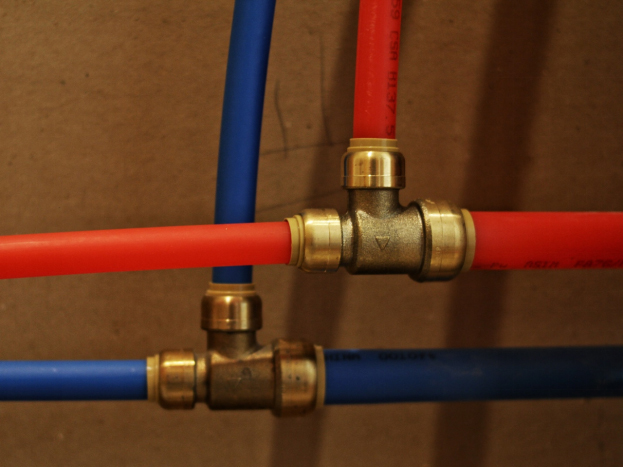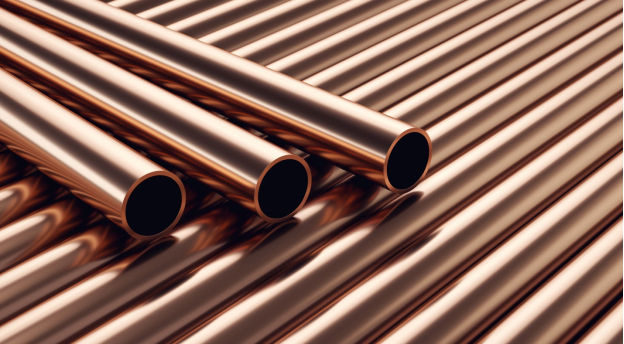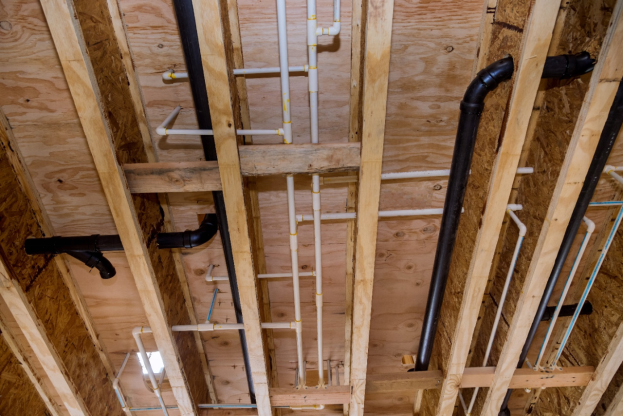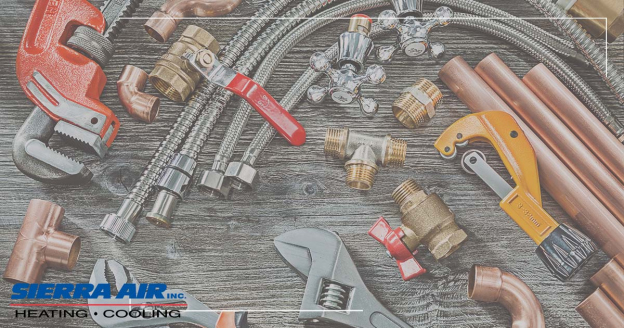Your home has multiple types of plumbing pipes that are used for different purposes, including carrying water to your kitchen faucet or flushing waste through your sewage system. The ancient Greeks used clay pipes to transport water to homes and public buildings, but we’ve evolved to use iron, copper, galvanized steel, and now, more advanced materials like PEX and PVC.
Find out the top 3 types of plumbing pipes you need to know from the experts at Sierra Air, your one-stop shop for everything fromplumbing service to furnace maintenance and repair.
PVC Pipes
Polyvinyl chloride pipes (PVC) are often used in the toilet, sink, or shower drain lines. Its plastic tubing is ideal for this type of plumbing usage because it protects water from rust and corrosion more effectively than other types of pipes. It’s also durable. If it doesn’t get damaged, PVC pipes will last forever.
If you have high water pressure, PVC pipe is the best option. It’s often used for the home’s main water supply line for this reason. It’s also a lightweight material that’s much easier to work with than galvanized steel or copper. PVC pipes have a smooth inner lining that prevents sediment buildup and resists blockages and contamination.
That said, PVC pipe isn’t perfect. There are drawbacks to its use, including limited sizing options and the inability to withstand extremely high temperatures. Some people are concerned over possible toxicity with plastic as well, but PVC piping meets all the standards set by theAmerican National Standards Institute. If this is a concern, other types of piping can be used to transport drinking water.
PEX Pipes
Cross-linked polyethylene (PEX) piping is an affordable plastic piping that’s often used for the water supply lines in homes. One of its major benefits is similar to PVC in that it prevents rust or corrosion from leaching into the water supply.

Professionals often prefer PEX pipes because they’re flexible and easy to weave through walls, ceilings, basements, and crawl spaces. Yet they’re strong enough to handle the high pressure of the water supply. They can be color-coded for hot and cold water, helping plumbers better identify and organize when they need to do plumbing repairs or replacements.
ABS Pipes
Acrylonitrile butadiene styrene (ABS) pipe is similar to PVC pipes but a black color. ABS pipes are resistant to cold temperatures, making them ideal for vent and drain lines that may be susceptible to temperature extremes and freezing.
ABS pipes are easy to install, but they can warp when exposed to direct sunlight. They’re also a bit noisier than other types of plumbing pipes, which may be a bother to some homeowners.
Other Types of Plumbing Pipes
In addition to the advanced types of piping that are commonly used in homes, there are other types of plumbing pipes:
Copper Pipes
Copper piping was a mainstay in home plumbing for decades. It can last for over 50 years and is the standard hard pipe within the plumbing industry. It’s able to withstand high water pressure and comes in a variety of thickness, separating into rigid and flexible options.

A rigid copper pipe is typically used for water supply lines, while flexible copper pipes are used in tight spaces where malleable copper can bend. Copper pipes are resistant to corrosion, durable enough for hot and cold temperatures. It is more expensive than alternatives like PVC or PEX.
Cast Iron and Galvanized Steel Pipes
Cast iron and galvanized pipes are rarely installed in new homes, but they are common in older homes that were built prior to the early 20th century. Cast iron pipes are still used today for parts of water distribution systems.
Unfortunately, both cast iron and galvanized pipes are prone to rust and corrosion over time, so they are often swapped for copper or plastic in residential plumbing repairs.
How to Choose the Right Plumbing Pipe for Your Needs
Selecting the right type of plumbing pipe for your home involves several factors. Here are some things to keep in mind:
- Application:Consider what purpose the pipes will serve in your overall plumbing system. For example, are they used for the hot or cold water supply or drainage? Different piping offers different advantages and disadvantages.
- Budget:If you’re on a tight budget, the types of plumbing pipes you can use may be limited. PVC and PEX pipes are more budget-friendly, whereas copper pipes are more expensive.
- Environmental impact:If you’re concerned about sustainability, you may want to choose materials like copper, which is easy to recycle, or PEX, which may have a lower overall environmental impact because of its lower energy requirements during manufacturing.
- Climate:Your area’s climate makes a difference in the pipes you choose. Reno and the surrounding areas don’t get freezing temperatures very often, but it may be worth considering pipes that are more resistant to freezing for your outdoor lines. Your plumbing technician can help you determine the best option for your home.
- Water quality:The quality of your water supply can impact your choice of plumbing pipe. Soft water with low mineral content may be less corrosive than copper or steel, while hard water may benefit from the corrosion resistance of PEX.
- Installation ease:Consider your own DIY capabilities if you want to install your own plumbing. PVC and PEX pipes are easy to work with and often preferred for DIY plumbing. That said, your plumbing is not something to take lightly. If you don’t have experience, it’s best to work with an experienced plumbing technician.
- Building codes:If local building codes and regulations apply to the types of plumbing materials you can use for specific applications, make sure your choice of pipes is compliant. Your plumbing technician can help with this aspect of the process.
- Goals for your home:Are you planning on staying in your home for a long time? If so, it’s best to make a sound investment in new pipes, even if the upfront cost is higher. This may also help your home’s resale value. If you’re considering your short-term options and working on a budget, PVC and PEX pipes may be the better choice.
How Long Do Plumbing Systems Last?
Your plumbing system takes a lot of wear and tear. While it can last a long time, especially with proper plumbing maintenance, it’s not designed to function indefinitely. However, if you have outdated pipes in your home, replacing them may be the best choice.
With care and maintenance, your plumbing can last several decades before different parts of the system need to be replaced. Different materials are designed to last different time periods, however. For example, copper can last 50 years or more, cast iron can last 75 to 100 years, and galvanized steel can last 20 to 50 years. In contrast, PVC can last indefinitely.

In addition, the pipes themselves may last decades, but the pipe joints, fittings, and other components that connect plumbing and fixtures can experience leaks, clogs, and other plumbing issues that warrant a replacement.
Here are some signs that you may need to replace your faucet, toilet, and drain pipes:
- Discolored water:Water that’s an unusual color or brownish may indicate pipe corrosion, which means your water supply is carrying particles that cause the discoloration.
- Water odor:Avoid using any water that has a strange odor for potable purposes, since this could mean that you have bacteria buildup inside the pipes or mold growth in your pipes and drains.
- Leaking pipes or fixtures:Note any obvious leaks like a broken fixture or damp spaces behind walls or around major appliances. You should also look at your water bill and see if it’s been slowly rising without an obvious cause. This could be a sign that you have a leak somewhere in your plumbing system.
- Slow drainage:If you have a drain that refuses to unclog, no matter how many times you try, it could mean that your pipes are corroded or have some deeper issue. Replacing that aspect of your plumbing system may be the best course of action.
- Low water pressure:Persistent low water pressure could indicate a clogged water pipe somewhere in your system, such as downstream from the fixture. This could also indicate a leaking pipe.
- Cracks:Though some signs of a failing plumbing system are difficult to spot, a crack is not one of them. If you see a crack in your plumbing pipe, it’s a clear visual sign that you need a repair or replacement. Even if the pipe is behind a wall or under a floor, you will see signs of water damage.
Schedule Your Plumbing Repair
Whether you’re looking for plumbing installation or you have outdated or damaged pipes and need a plumbing replacement, Sierra Air is here to help with all your plumbing needs. Our skilled and experienced plumbers can help you determine the right course of action for your plumbing according to your home, goals, and budget.
Ready for your plumbing service?Contact us at Sierra Air to schedule your appointment!




